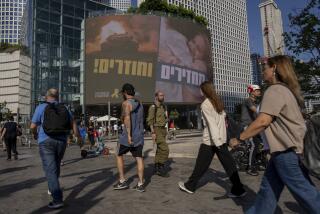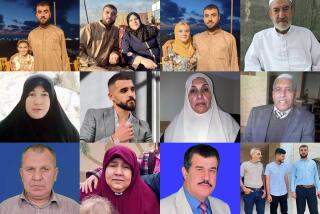‘I watched her die’: The last push for Mosul, from those who lived through the ferocious battle
Reporting from MOSUL, Iraq — For more than a week, 13-year-old Majed Ali and his family had played a deadly game in what had become the killing grounds of Mosul’s Old City quarter.
“We moved to four different houses, and every time the planes hit us,” said Ali, his outsized brown eyes wide with excitement as he described how he, his mother, two brothers and sister had barely escaped the bare-knuckled melee between Iraqi government forces and the jihadis of Islamic State.
The last strike Ali survived, on Wednesday morning, had collapsed the roof with the family bunkered in the basement. “We were coughing and choking from the smoke and the debris,” he said.
Ali recounted the last push to recapture Mosul while huddled with dozens of other civilians who had been evacuated by bus to a makeshift registration center set up in an abandoned amusement park. As the women and children shuffled inside a tent in the shadow of a rusty Ferris wheel, volunteer doctors and nurses from the provincial government’s health department scrambled to treat them.
Iraqi Prime Minister Haidar Abadi declared all-out victory in Mosul early last week, but clashes have continued, with the militants squeezed into a thin line of territory along the Tigris River.
Still, the military’s advance was the opening hundreds of families needed to escape. At the registration center, the evacuees described the deaths of loved ones, desperate attempts to escape and daring rescues.
Ali said his family was trapped in the basement until the military arrived.
“We heard soldiers removing the wreckage, and then a bulldozer helped clear the way. We just ran to them,” he said.
At the former amusement park, evacuees received medical aid, often for dehydration, while also being investigated for Islamic State links. An area to the side of a rink where children used to ride in green-and-purple bumper cars was now used as a screening area for the men, who sat glumly on straw.
The faces of evacuees often bore the slashes left by shrapnel, or sported dirty bandages tinged crimson with dried blood.
“It’s fear, always fear. There’s no such thing as not being afraid in there,” said Abeer Wissam, a young woman who was finally evacuated when she and other members of her family reached the riverfront and got the attention of security forces nearby.
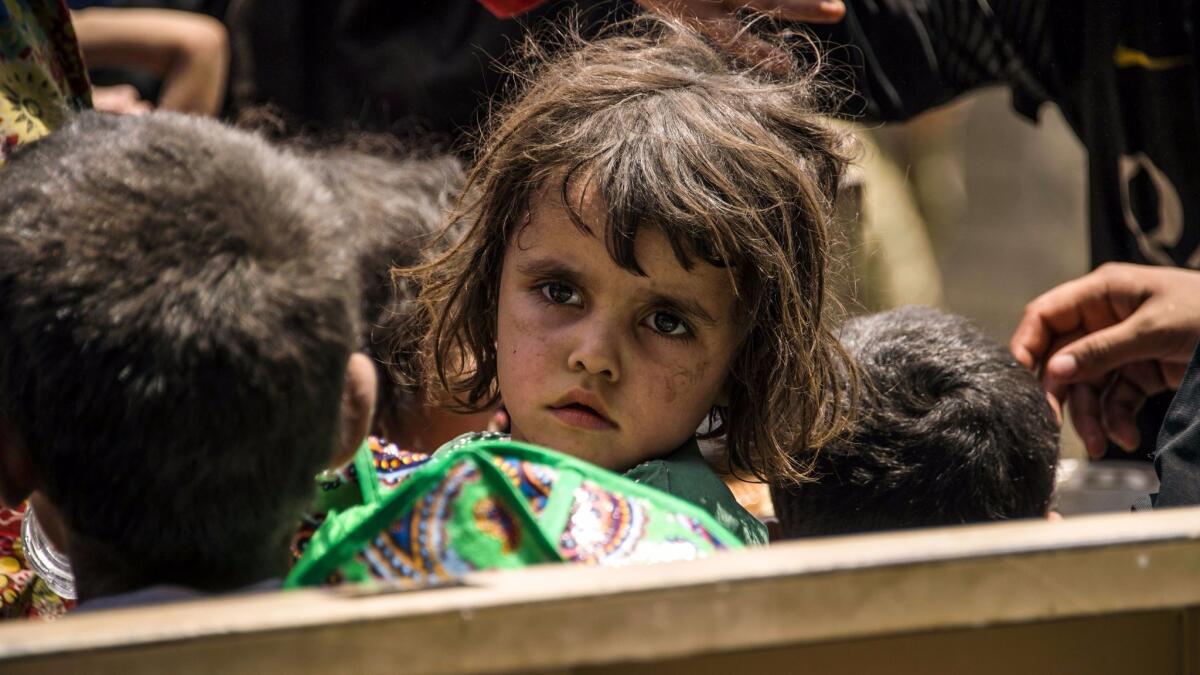
Another woman, Mohjah Mahmoud, recounted how she and two sisters along with seven children had repeatedly tried to reach the riverfront all week, but were stopped every time by a heavy barrage.
When they finally made it Wednesday, army snipers on the other side of the river almost shot them, she said, before it became clear they were refugees and security forces reached them.
“We were running over bodies. We saw kids dead in the streets,” she said, her face spotted with dirt.
Some refugees appeared desiccated from lack of water and food. All were exhausted, their ragged clothes streaked with dirt and white rings of dried sweat.
Amer Ibrahim was among the doctors examining them.
“My job is to give the refugees a checkup when they come here. The biggest issues are dehydration and malnutrition, but they’re also suffering from scabies,” said Ibrahim, who brandished a color-coded tape. He expertly wrapped the tape above the elbow of a crying baby girl cradled by her mother.
“The measurements should be green, but most of what we get here is yellow and red — medium and acute malnutrition.”
Soon he and his team were in the tent handing out packets of high-energy snacks and coaxing ampules of vitamins into babies’ mouths.
Those inside the tent seemed dazed, anxiously inquiring if anyone had seen a family member, or asking for some way to contact a relative to come collect them. Children wailed themselves to sleep, even as some mothers, their energy all but depleted, lay down on the rough mats for a moment’s rest.
Back in the Old City, the skirmishes had left only 50 square yards of devastated buildings in the hands of the militants. Over the last week, the militants had released numerous videos on official Islamic State channels vowing that, though they were “overburdened with wounds,” they would fight “until the last breath.”
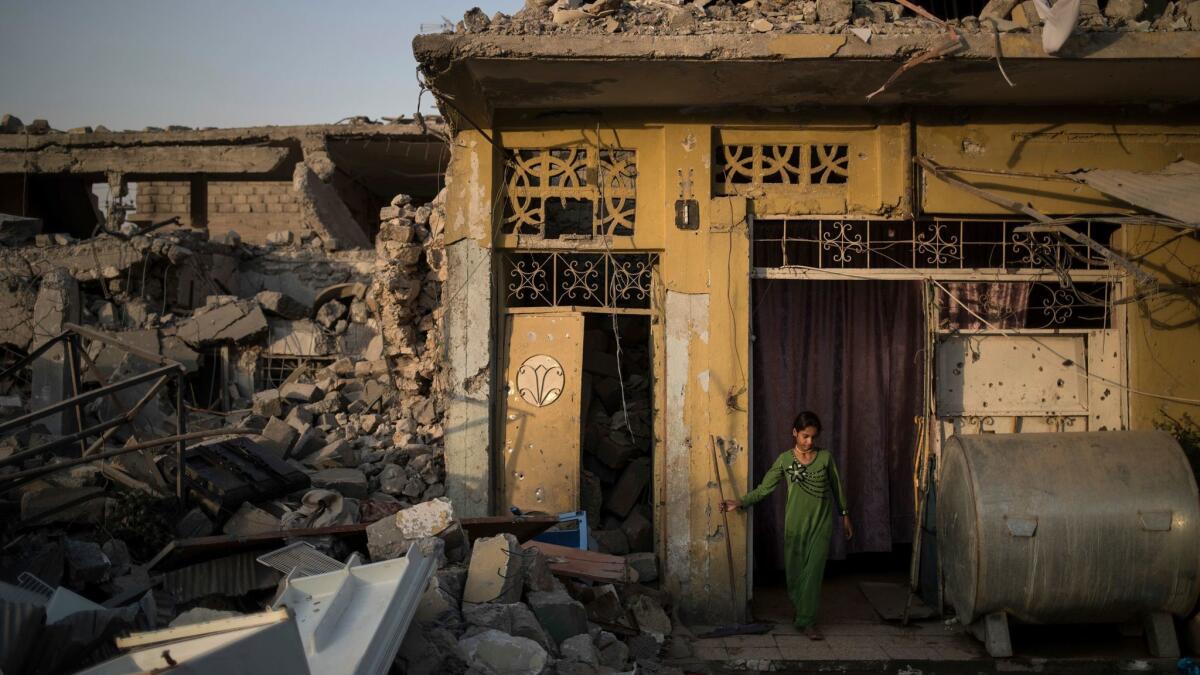
Their corpses, left inside houses or at the sides of the narrow passageways, showed they had done just that.
The body of one militant, his head and left hand swathed in bandages, lay on a ravaged stairway with a suicide belt still wrapped around the torso. He had been killed, soldiers nearby said, when he was charging at the incoming troops.
“The other day we killed one Daesh guy with an amputated hand,” said 1st Lt. Mohammad Saheb in an interview at the frontline, using an Arab term for Islamic State.
“He was wounded too, shot in his side. But he still kept coming.”
On Thursday, the militants had been cornered into a small number of destroyed buildings at the very edge of the river, as the 16th Army Division’s units sprayed their positions with 50-caliber machine guns from a nearby hill.
But the bullets had little effect; with all structures leveled, the fighting had shifted to the warren of tunnels the militants had dug beneath the surface.
“They’re like worms. They die and others show up. If the planes can’t strike the tunnel, they’ll keep on coming out,” said Ahmad Idris, a dust-covered soldier who had just come back from the front.
“And you see the women inside with suicide belts. … These people aren’t human.”
A United Nations damage assessment released Thursday said that, up to last week, almost 5,400 buildings “were heavily damaged or completely destroyed.”
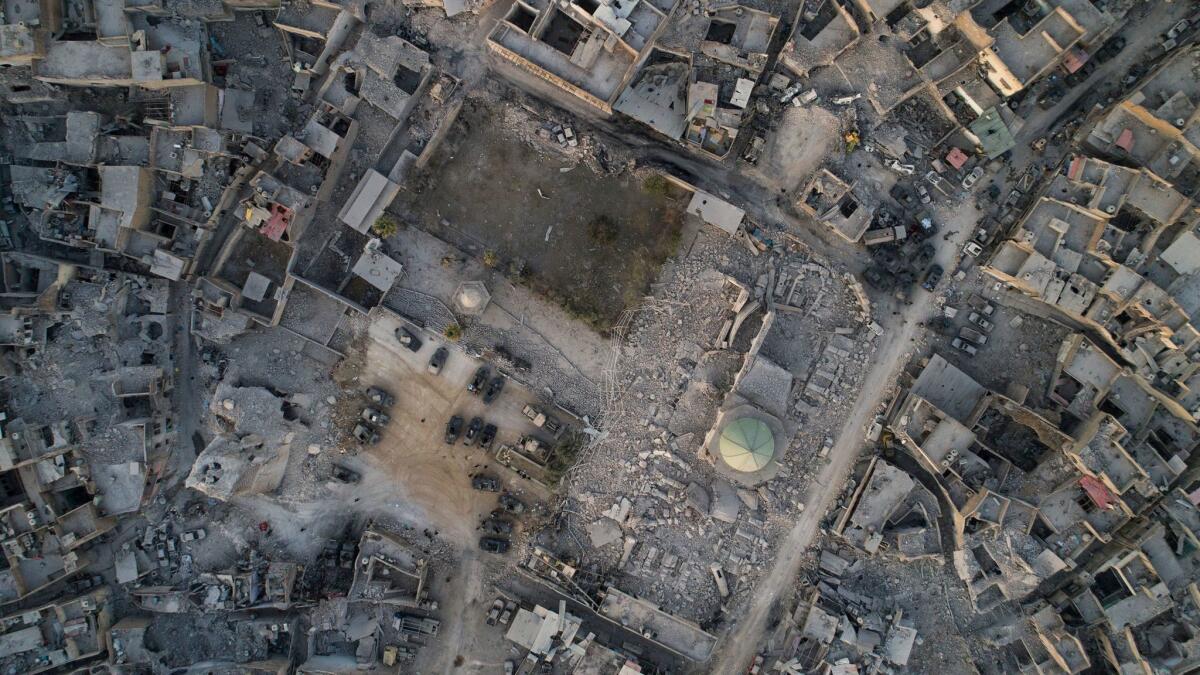
A walk through the ruins shows entire blocks pulverized into a dusty sea of rocks. The detritus hints at the ferocity of the battle. Hundreds of bullet casings clink underfoot, while spindly bits of flesh, torn off by a shell, lie in a corner.
The rare structures still standing have entire walls sheared off, exposing the innards of homes like life-size dollhouses. The air is heavy with the smell of putrescence from thousands of bodies waiting to be exhumed from under the wreckage.
Of the 54 residential neighborhoods in Mosul’s western half, where the Old City is located, 15 have been “flattened,” said Grande, the U.N.’s humanitarian coordinator, in a phone interview. Another 23 neighborhoods suffered moderate damage.
She noted that some people are trapped in devastated portions of the city and living “in the worst condition of all civilians.”
They haven’t been able to reach Iraqi troops. “Most of those remaining are children, disabled, the elderly … and many of them are too weak to cross the line. It’s unimaginable,” Grande said.
The battle continues amid criticism from human rights group Amnesty International, which accused Iraqi forces and the coalition in a report earlier this week of using indiscriminate weapons and unnecessary force near civilians. Coalition military commanders dismissed the report as “irresponsible” and an “insult” to those fighting Islamic State.
On the front line, Iraqi commanders were unapologetic.
“If it were in my hands, I would have dubbed this World War III,” said Brig. Gen. Dergham Ahmad, moments before he ordered his men of the 75th Brigade to advance “no matter what.”
For the civilians taken to the evacuation center, they now wrestle with memories of Islamic State’s occupation.
“We’ve been trying to escape since two weeks ago, but the Dawaesh told us, ‘If you leave we will be bombed,’” said Khaleda Hussein, a 46-year-old woman who employed the pejorative term for Islamic State fighters. She looked almost wild, her black hair chaotically pushing out of a grimy gauze wrapping on her head.
She and her family of six, she said, were put in a basement with the muhajiraat, the foreign wives of the militants, and threatened with death if they tried to escape.
“Then yesterday we were bombed. I lost consciousness and next thing I woke up to the army coming for us. It’s a miracle we got out alive.”
But not everyone in her family had survived.
“Aya, Amina, Muumen…” said Huda Hassan, Hussein’s 25-year old daughter, matter-of-factly reciting the names of her two sisters and brother killed in the attack.
“I just managed to see a block fall on my mother. I could barely get up, but when the dust settled, I saw that my sister had a piece of shrapnel in her back. I watched her die.”
Hussein turned to a visiting reporter, her voice husky with emotion as she said, “I lost two girls and a son, and I have two girls and a son left.”
Twitter: @nabihbulos
Bulos is a special correspondent.
ALSO
The ‘caliphate’ is all but lost, yet Islamic State’s threat remains potent
Warriors, dreamers and just plain crazy: U.S. civilian volunteers fighting Islamic State in Syria
The long and bloody battle for Mosul
More to Read
Sign up for Essential California
The most important California stories and recommendations in your inbox every morning.
You may occasionally receive promotional content from the Los Angeles Times.
